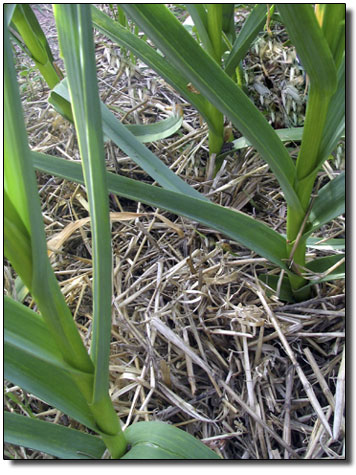| ||
Much ado about mulching
by Chef Boy Ari These days, it’s not a problem to be in the garden. There are more warm spots in the sky, but enough weather to keep you close to home. The mountains are still melting, the rivers are big and cold, while outside your door the birds and flowers and worms and bees are buzzing pleasantly, thanks to the sun and rain of springtime. As you pull your baby weeds from your baby carrots, or prepare the ground to receive a farmer’s market impulse purchase, anything seems possible. This is when big plans are made, hubric proclamations of majesty like “This is the year my garden rocks like never before.” Unfortunately, as spring changes to summer, something happens. The honeymoon doesn’t ever really end, but distractions pop up everywhere. It’s summertime, the living is easy, the river’s calling, and the weeds are high. All of a sudden, the quack grass that snuck into the onions is taller than the onions. Elsewhere, the intruders you ignored when they were wee weeds have overtaken your stunted cucumbers, and the few cukes that manage to ripen are hiding behind the weeds, split and rotting on the ground. And when you search for your long-lost garden, sometimes the hard dirt won’t give up its weeds. At this point, you can still get your garden back on track. Through June, it’s not too late with a heroic effort. In July, your garden might bounce back, but it won’t catch up to where it would have been. This won’t be “the year.” By August, not all your weeds have gone to seed, so you can still provide a valuable service to yourself by intercepting next year’s weeds before they’re even born. Bravo. But if you’re really on the ball, weeding’s never even necessary. With strategic application of mulch right now – i.e., the ideal time to be in the garden – the weeds won’t ever show up. Mulch is something that covers the soil, thereby blocking sun, retaining moisture, regulating temperature and preventing weeds. Ron Engeland, in his definitive book Growing Great Garlic, claims to “…mulch with the dedication of a champion chess player, and the fervent sincerity of a young priest.” Based in part on what I learned in Ron’s book, I too have come to mulch with a passion. After first observing the benefits of mulch on garlic, I’ve subsequently used it on onions, strawberries, corn, beans, squash … things I don’t feel like weeding, including garden paths, flower beds and fruit trees. My favorite mulch, for most applications, is straw, because it’s cheap, easy to work with, and makes everything look really nice. The biggest problem with straw is when straw isn’t straw, but hay, which has seeds, and putting hay on your garden amounts to seeding it with weeds. But a thick mat of honest straw will smother anything you want, keep moisture where it belongs, and keep the soil warm, soft and alive with microbial action, which increases fertility And there are other perks. Red strawberries, for example, like to rest upon the blonde straw, away from slugs, dirt, and rot, while allowing for clean, in-garden feasting. This time of year, it’s a bit tough to find straw, but if you check around, you can probably get it. Otherwise, grass clippings, long or short, make a good substitute. If you can’t get enough clippings from your yard, cruise the alleyways in your neighborhood. There are plenty of generous souls who go to the trouble of packaging their valuable clippings in conveniently identifiable round plastic bags. Just watch out for export product from yards where dogs roam, for obvious reasons, and for other signs of contamination. It’s always a good idea to knock on the door and ask first, and when you do, ask if they use chemicals on their lawn, or if their house has lead paint, or toxic waste buried in the yard. Be prepared to back away politely. Garden stores also sell ready-made mulches. These can be a bit spendy, depending on the type and size of the area you want to cover. But you can easily justify the expense by putting a price tag on your labor and calculating how much time weeding in the hot sun you’ll save, when you could be swimming. Confirm that the mulch is appropriate for vegetable gardens, as opposed to ornamentals. Or, mulch with whatever’s around, and see what happens. Maple leaves are good. No pine needles, please, and I would stay away from wood chips in the veggies. Whatever you use, the occasional weed that makes it through your mulch will be easily pulled, because the cool and loose soil will generously relinquish the roots of the offending plant. But before you go out there like a fervent young priest and mulch everything in sight, remember that certain things shouldn’t be mulched. Tomatoes, for example, like their roots to dry out between waterings. Fruit trees need a little mulch-free space near the trunk. Salad greens, meanwhile, can be planted so thickly that they act as their own mulch, carpeting the ground. So, get out there in the beautiful weather, enjoy yourself, and get your mulch on. Your garden will rock you for it. •
|


